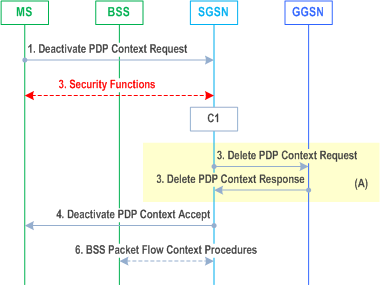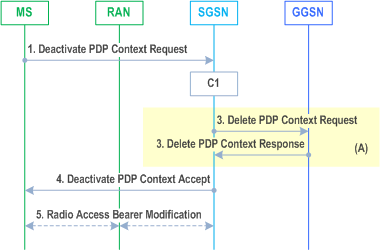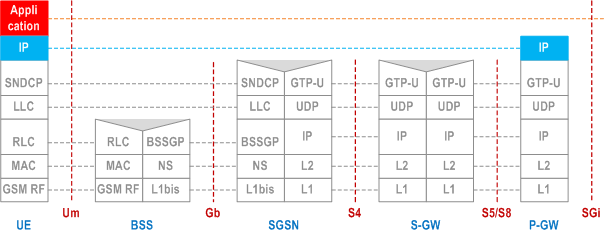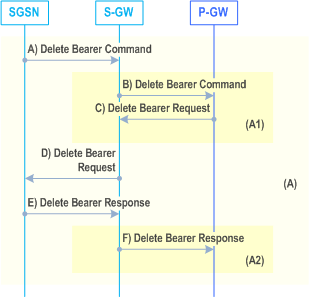Content for TS 23.060 Word version: 18.0.0
1…
5…
5.3.8…
5.4…
5.4.2…
5.4.9…
5.6…
5.6.2
5.6.3…
5.6.3.7…
5.7…
6…
6.3…
6.5…
6.6…
6.8…
6.9…
6.9.1.3
6.9.2…
6.9.2.2…
6.9.2.2.2
6.9.2.2.3…
6.9.2.2.5…
6.9.3…
6.10…
6.12…
6.13…
6.13.1.2…
6.13.2…
6.13.2.2
6.14…
8…
8.2
9…
9.2.2…
9.2.2.2
9.2.2.3…
9.2.3…
9.2.3.2…
9.2.3.3…
9.2.4…
9.2.4.2…
9.2.5…
12…
12.5…
12.6…
12.7…
12.8…
13…
14…
15…
15.3…
16…
16.2…
A…
B…
9.2.4 Deactivation Procedures
9.2.4.1 MS Initiated PDP Context Deactivation Procedure
9.2.4.1A MS- and SGSN Initiated Bearer Deactivation Procedure using S4
...
...
9.2.4 Deactivation Procedures p. 272
9.2.4.1 MS Initiated PDP Context Deactivation Procedure p. 272
The PDP Context Deactivation Initiated by MS procedures for A/Gb mode and Iu mode are illustrated in Figure 74 and Figure 75, respectively.


Step 1.
At GPRS detach, all PDP contexts for the MS are implicitly deactivated.
If the SGSN receives a Deactivate PDP Context Request (TI) message for a PDP context that is currently being activated, the SGSN shall stop the PDP Context Activation procedure without responding to the MS, and continue with the PDP Context Deactivation initiated by MS procedure.
The SGSN determines the Maximum APN Restriction for the remaining PDP contexts and stores this new value for the Maximum APN Restriction.
The CAMEL procedure call shall be performed, see referenced procedure in TS 23.078:
The MS sends a Deactivate PDP Context Request (TI, Teardown Ind) message to the SGSN. If the MS deactivates the PDP context created by the PDP Context Activation Procedure, the Teardown Ind shall be sent.
Step 2.
In A/Gb mode security functions may be executed. These procedures are defined in clause "Security Function".
Step 3.
If the PDP Context was served by a GGSN, the SGSN sends a Delete PDP Context Request (TEID, NSAPI, Teardown Ind, CGI/SAI Information) message to the GGSN. If the MS in the Deactivate PDP Context Request message included Teardown Ind, then the SGSN deactivates all PDP contexts associated with this PDP address and the same APN by including Teardown Ind in the Delete PDP Context Request message. The GGSN removes the PDP context(s) and returns a Delete PDP Context Response (TEID) message to the SGSN. If the MS was using a dynamic PDP address allocated by the GGSN, and if the context being deactivated is the last PDP context associated with this PDP address, then the GGSN releases this PDP address and makes it available for subsequent activation by other MSs. The Delete PDP Context messages are sent over the backbone network. The GGSN may interact with the PCRF (refer to TS 23.203), e.g. to deliver User Location Information and/or UE Time Zone Information if it was requested by the PRCF. For PDP Context using a T6b connection to the SCEF the SGSN indicates to the SCEF that the connection for the MS is no longer available according to TS 23.682.
Step 4.
The SGSN returns a Deactivate PDP Context Accept (TI) message to the MS. If this deactivates the last PDP context of the UE then an E-UTRAN capable MS not using CIoT GSM Optimization shall set its TIN to "P-TMSI". If PDP contexts remain for the MS, the SGSN recalculates the UE-AMBR and updates the RAN accordingly.
Step 5.
In Iu mode, radio access bearer release is done by the RAB Assignment procedure, if a RAB exists for this PDP context.
Step 6.
In A/Gb mode, BSS packet flow context procedures may be executed. These procedures are defined in clause "BSS Context".
C1) CAMEL_GPRS_PDP_Context_Disconnection.
The procedure returns as result "Continue".
9.2.4.1A MS- and SGSN Initiated Bearer Deactivation Procedure using S4 |R8| p. 273
When MS- and SGSN initiates Bearer Deactivation procedure,
- If the Tear Down Indicator (Teardown Ind) is set, the procedure in clause 9.2.4.1A.1 is used.
- Otherwise, the procedure in clause 9.2.4.1A.2 is used.
9.2.4.1A.1 MS-and SGSN Initiated PDN connection Deactivation Procedure using S4 p. 273
The procedure described in Figure 74a is used when the MS/SGSN initiates PDN connection deactivation.

A)
The EPS Bearer in the Serving GW regarding this particular MS and the PDN are deactivated by the SGSN by sending Delete Session Request (TEID, EPS Bearer Identity, Teardown Ind, User Location Information), to the Serving GW. This message indicates that all bearers belonging to that PDN connection shall be released.
B)
The Serving GW sends Delete Session Request (TEID, EPS Bearer Identity, Teardown Ind, User Location Information, User CSG Information) to the PDN-GW. This message includes an indication that all bearers belonging to that PDN connection shall be released, i.e. the Teardown Ind. The PDN-GW may interact with PCRF (refer to TS 23.203), e.g. to deliver User Location Information and/or UE Time Zone Information if it was requested by the PRCF.
C)
The PDN-GW acknowledges the bearer deactivation to the S-GW by sending a Delete Session Response (TEID).
D)
The Serving GW acknowledges the bearer deactivation to the SGSN with Delete Session Response (TEID).
9.2.4.1A.2 MS-and SGSN Initiated Bearer Deactivation Procedure p. 274
The procedure described in Figure 74b is used when the MS/SGSN initiates Bearer Deactivation procedure.
In case of RNC Failure, SGSN may based on operator policy either preserve all bearers or initiate the Dedicated Bearer Deactivation procedure, as shown in Figure 74b below. In deactivating the GBR bearers, SGSN may take the EPS bearer QoS into account.

A)
The SGSN sends the Delete Bearer Command (EPS Bearer Identity) message to the Serving GW to deactivate the selected EPS bearer.
B)
The Serving GW sends the Delete Bearer Command (EPS Bearer Identity) message to the PDN-GW.
C)
The PDN-GW sends a Delete Bearer Request (TEID, EPS Bearer Identity) message to the Serving GW. The PDN-GW may have interacted with PCRF beforehand (refer to TS 23.203).
If the bearer deleted is the default bearer (i.e. the UE is not supporting the default bearer concept) it is implementation specific whether the PDN-GW keeps the rest of the EPS bearer(s) for the PDN connection or whether the PDN-GW initiates a deactivation of the PDN connection.
D)
The Serving GW sends the Delete Bearer Request (TEID, EPS Bearer Identity) message to the SGSN.
E)
The SGSN deletes the bearer contexts related to the deactivated EPS bearer and acknowledges the bearer deactivation to the Serving GW by sending a Delete Bearer Response (TEID, EPS Bearer Identity, User Location Information) message.
F)
The Serving GW deletes the bearer context related to the deactivated EPS bearer and acknowledges the bearer deactivation to the PDN-GW by sending a Delete Bearer Response (TEID,EPS Bearer Identity, User Location Information, User CSG Information) message. The PDN-GW may interact with the PCRF (refer to TS 23.203), e.g. to deliver User Location Information and/or UE Time Zone Information if it was requested by the PRCF.